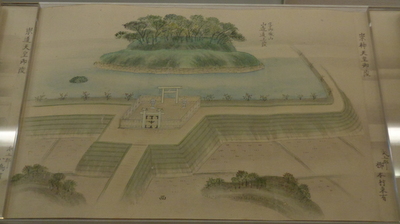Emperor Sujin
- 3th-4th century/highly fabricated
- Other names: Prince Mima, Prince Mimaki
Emperor Sûjin is traditionally said to have been the 10th Japanese emperor; traditional counts place his rule around 97-30 BCE. According to some accounts, he may have founded Ise Shrine.[1]
If he was a historical figure, and not merely mythical, Sûjin may have lived several centuries later, in the mid-3rd century, and may have been the first Yamato ruler, after the mysterious Yamatai confederacy fell into disunity.
Conditions on the Archipelago
To understand Emperor Sujin's place in Japanese history, it's necessary to analyze the waves of immigrants and imported technology that arrived from China and Korea before the 4th century.
The native Jomon people, who occupied the Japanese islands from 8500-300 B.C., were gradually displaced by continental immigrants during the 4th and 3rd centuries B.C. These waves of immigrants coincided with the petering out of the Zhou Dynasty of China.
Bearing iron and bronze weapons, the hunter-gatherer Jomon people easily overtaken and subdued. Japan then entered the Yayoi Period, which lasted from 300 B.C. to 250 A.D., which was characterized by widespread agriculture and the adoption of iron and bronze weapons and farming implements.
After the birth of Christ, from 100 A.D. to 250 A.D. (late Yayoi), warfare spread for the first time on the Japanese archipelago. Agriculture created an imbalance of power between villages, which was only rectified by fighting.
Another wave of continental immigrants came around the 3rd century A.D. However, because these emigrants met the previous continental immigrants who had similar warring technology, the transition to Japanese soil was not as smooth as had previously been witnessed in the Jomon Period. Sweeping the archipelago from West to East, the newcomers displaced the Yayoi peoples.
Prince Mima (Emperor Sujin) is believed to have been one of these aggressive newcomers.
Prince Mima
During the 7th century, texts such as the Fudoki, Kojiki, and Nihon Shoki rewrote or created myths and stories to glorify important figures, or give heavenly precedent to perhaps questionable earthly action. One such example is the following from the Hitachi no Kuni Fudoki.
| Aoki, Michiko Y. Records of Wind and Earth. Michigan: Association for Asian Studies, Inc., 1997. 8-9. | |
The god who appeared to Prince Mimaki was quite an expansionist, as were the councilors of the prince. Prince Mimaki straightaway summoned them in order to consult them on the matter. Among them was none other than Kikikatsu (Wise Listener), the legendary progenitor of the Nakatomi clan. He advised the prince, saying, "this is the god’s pronouncement. He is the Great God of Kashima. He appeared in order to remind you that you are the one to whom the ancestral deities entrusted the rule of these Great Eight Islands." | |
Sources
- Aoki, Michiko Y. Ancient Myths and Early History of Japan. New York: Exposition Press, 1974. 15-25.
- Aoki, Michiko Y. Records of Wind and Earth. Michigan: Association for Asian Studies, Inc., 1997.
